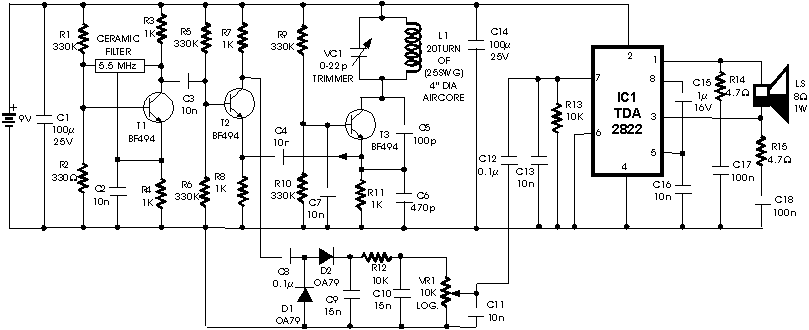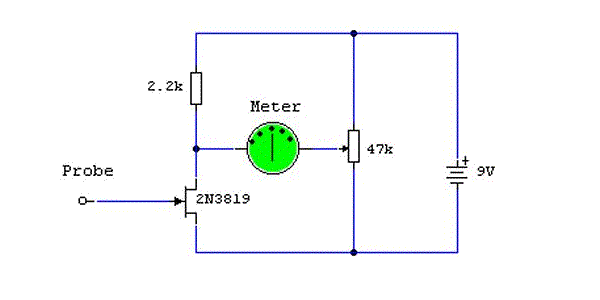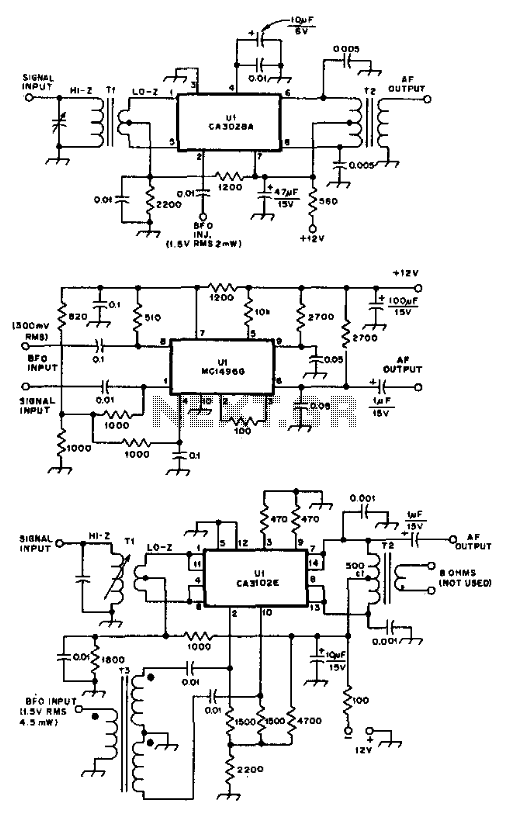
Ssb/Cw Product Detectors

These circuits are utilized for the detection of single-sideband (SSB) and continuous wave (CW) signals. The beat frequency oscillator (BFO) injection is generally in the range of 0.5 to 1 V rms for both circuits. The operational frequencies can reach up to approximately 25 MHz.
The circuits designed for the detection of single-sideband (SSB) and continuous wave (CW) signals are essential in various communication applications. These circuits leverage the principle of modulation and demodulation to extract information from the modulated carrier wave. The primary component in these circuits is the beat frequency oscillator (BFO), which plays a crucial role in the demodulation process.
The BFO generates a signal that mixes with the incoming SSB or CW signal. The injection level of the BFO, typically ranging from 0.5 to 1 V rms, ensures that the mixing process effectively produces the desired output without introducing excessive noise or distortion. This voltage level is critical for maintaining the integrity of the signal during detection.
Operating at frequencies up to approximately 25 MHz, these circuits must be designed with careful consideration of frequency response and bandwidth. The choice of components, such as filters and amplifiers, is vital to ensure that the circuit can handle the high-frequency signals while minimizing interference and maximizing sensitivity.
In practical applications, these circuits are commonly found in receivers for amateur radio, military communication systems, and other RF applications where SSB and CW signals are prevalent. The design must also consider factors such as impedance matching, power supply requirements, and thermal management to ensure reliable operation across the specified frequency range. These circuits are used for product detection of single-sidebound (SSB) and CW signals. BFO injection is typically 0.5 to 1 V rms for both circuits. Frequencies can be up to 25 MHz or so.
The circuits designed for the detection of single-sideband (SSB) and continuous wave (CW) signals are essential in various communication applications. These circuits leverage the principle of modulation and demodulation to extract information from the modulated carrier wave. The primary component in these circuits is the beat frequency oscillator (BFO), which plays a crucial role in the demodulation process.
The BFO generates a signal that mixes with the incoming SSB or CW signal. The injection level of the BFO, typically ranging from 0.5 to 1 V rms, ensures that the mixing process effectively produces the desired output without introducing excessive noise or distortion. This voltage level is critical for maintaining the integrity of the signal during detection.
Operating at frequencies up to approximately 25 MHz, these circuits must be designed with careful consideration of frequency response and bandwidth. The choice of components, such as filters and amplifiers, is vital to ensure that the circuit can handle the high-frequency signals while minimizing interference and maximizing sensitivity.
In practical applications, these circuits are commonly found in receivers for amateur radio, military communication systems, and other RF applications where SSB and CW signals are prevalent. The design must also consider factors such as impedance matching, power supply requirements, and thermal management to ensure reliable operation across the specified frequency range. These circuits are used for product detection of single-sidebound (SSB) and CW signals. BFO injection is typically 0.5 to 1 V rms for both circuits. Frequencies can be up to 25 MHz or so.




